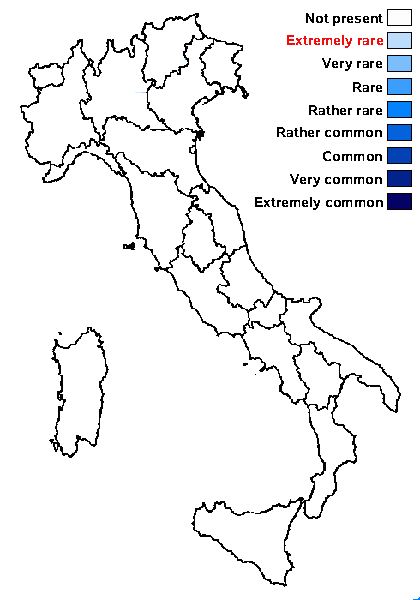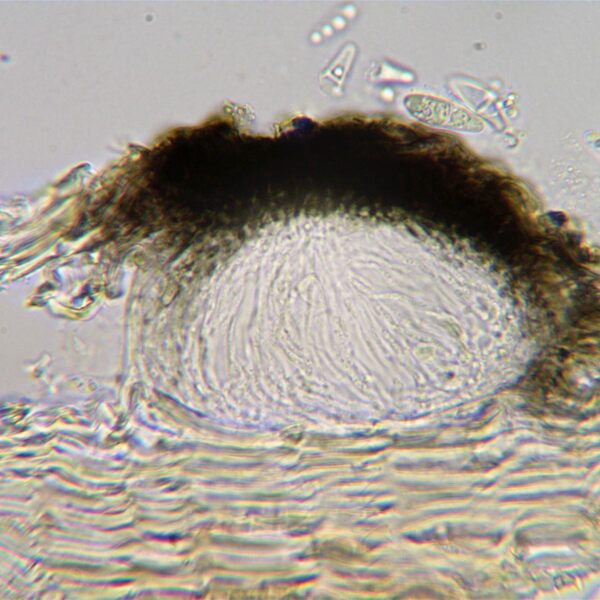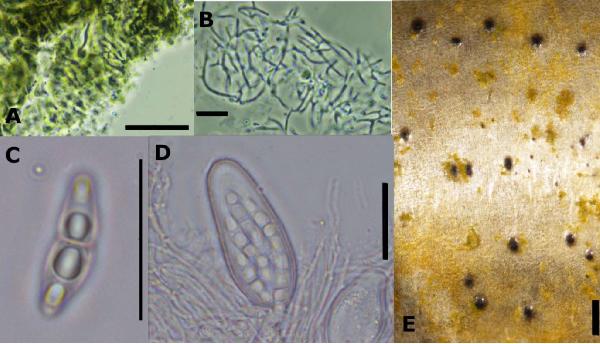Anisomeridium viridescens (Coppins) R.C. Harris
More Florida Lichens, Incl. 10 Cent Tour Pyrenolichens, New York: 151, 1995. Basionym: Arthopyrenia viridescens Coppins - Lichenologist, 20: 322, 1988
Synonyms:
Distribution:
Description: Thallus crustose, ecorticate, poorly evident, usually appearing as a whitish to pale brown stain on bark, sometimes with a pinkish hue when fresh. Perithecia black, 0.1-0.2 mm across, circular to ellipsoid, mostly scattered. Involucrellum brown, K+ green; exciple brown in upper part; paler and thinner in lower part, of cellular hyphae, usually without bark cells; pseudoparaphyses 0.8-1 µm thick, persistent, much branched and anastomosing, the cells 4-10 µm long; periphyses absent. Asci 8-spored, obclavate to short-cylindrical, K/I-, fissitunicate, the apical dome with an indistinct ocular chamber, 31-49 x 11-17 µm. Ascospores, 1-septate, hyaline or sometimes turning pale brown when overmature, usually constricted at septum, the upper cell wider than the other, both cells usually biguttulate, without a median constriction, 12-17(-19) x 3.5-4.7 µm. Pycnidia black, 0.04-0.05 mm across, producing either: a) oblong, 2-3-guttulate macroconidia measuring 9-11 x 2-2.5 µm, or, b) ovoid-oblong to bacilliform, eguttulate microconidia measuring c. 4-5 x 1-1.3 µm. Photobiont trentepohlioid. Spot tests: thallus K-, C-, KC-, P-, UV-. Chemistry: without lichen substances.Note: an apparently mainly western species growing on smooth bark, especially of Corylus in undisturbed old-growth forests, also reported from Austria. To be looked for in Italy.
Growth form: Crustose
Substrata: bark
Photobiont: Trentepohlia
Reproductive strategy: mainly sexual
Most common in areas with a humid-warm climate (e.g. most of Tyrrenian Italy)

Predictive model

Image uploaded by Mark Powell - CC BY-NC Source: https://fungi.myspecies.info/all-fungi/anisomeridium-viridescens
UK

Source: Nordén, B. & Aptroot, A. 2018. Anisomeridium viridescens and Arthopyrenia callunae, two pyrenolichens new to Fennoscandia. Graphis Scripta 30 (10): 166–169. Oslo. ISSN 2002-4495. - CC BY-4.0
Anisomeridium viridescens (A–D in KOH). A: Peridium with KOH green colour reaction. B:
Pseudoparaphyses. C: Ascospore. D: Ascus. E: Ascomata. Scale bars: A, C, D: 20 μm, B: 10 μm, E: 0.5 mm.
A–B: Valvatnavågen material, C–E: Huglo material. Photos: M. Jäntti
Growth form: Crustose
Substrata: bark
Photobiont: Trentepohlia
Reproductive strategy: mainly sexual
Most common in areas with a humid-warm climate (e.g. most of Tyrrenian Italy)

Predictive model

Image uploaded by Mark Powell - CC BY-NC Source: https://fungi.myspecies.info/all-fungi/anisomeridium-viridescens
UK

 INDEX FUNGORUM
INDEX FUNGORUM
 GBIF
GBIF

